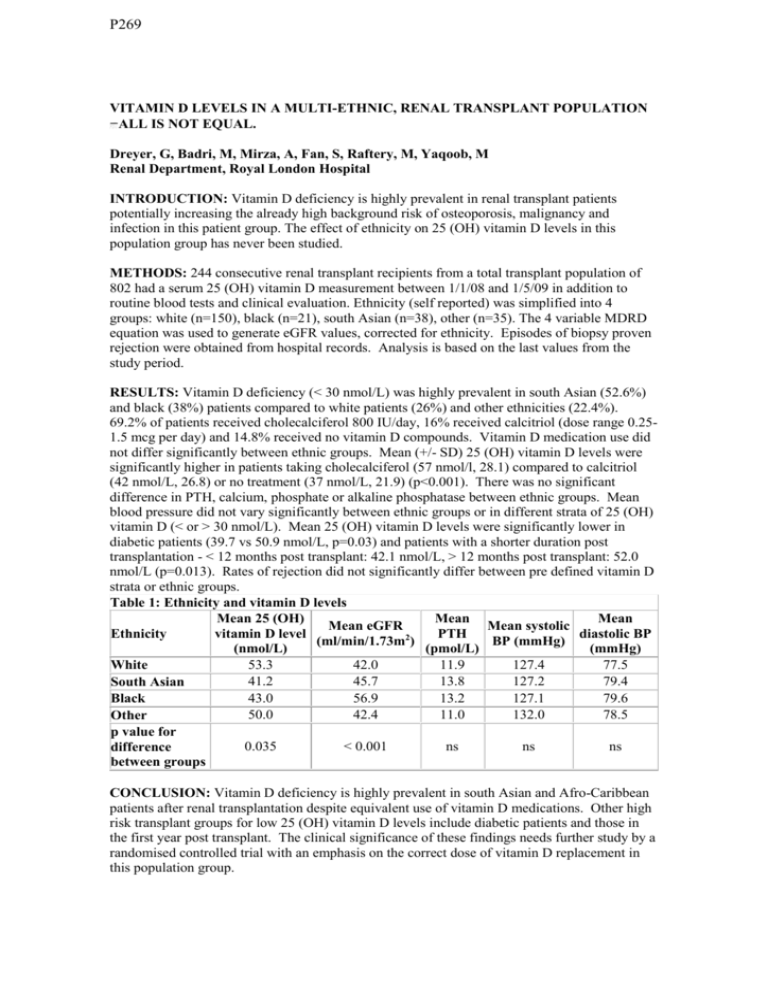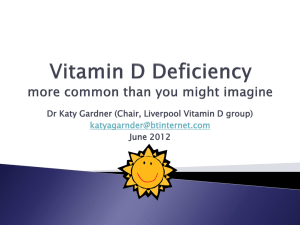Title: Vitamin D levels in a multi-ethnic, renal transplant population
advertisement

P269 VITAMIN D LEVELS IN A MULTI-ETHNIC, RENAL TRANSPLANT POPULATION ALL IS NOT EQUAL. Dreyer, G, Badri, M, Mirza, A, Fan, S, Raftery, M, Yaqoob, M Renal Department, Royal London Hospital INTRODUCTION: Vitamin D deficiency is highly prevalent in renal transplant patients potentially increasing the already high background risk of osteoporosis, malignancy and infection in this patient group. The effect of ethnicity on 25 (OH) vitamin D levels in this population group has never been studied. METHODS: 244 consecutive renal transplant recipients from a total transplant population of 802 had a serum 25 (OH) vitamin D measurement between 1/1/08 and 1/5/09 in addition to routine blood tests and clinical evaluation. Ethnicity (self reported) was simplified into 4 groups: white (n=150), black (n=21), south Asian (n=38), other (n=35). The 4 variable MDRD equation was used to generate eGFR values, corrected for ethnicity. Episodes of biopsy proven rejection were obtained from hospital records. Analysis is based on the last values from the study period. RESULTS: Vitamin D deficiency (< 30 nmol/L) was highly prevalent in south Asian (52.6%) and black (38%) patients compared to white patients (26%) and other ethnicities (22.4%). 69.2% of patients received cholecalciferol 800 IU/day, 16% received calcitriol (dose range 0.251.5 mcg per day) and 14.8% received no vitamin D compounds. Vitamin D medication use did not differ significantly between ethnic groups. Mean (+/- SD) 25 (OH) vitamin D levels were significantly higher in patients taking cholecalciferol (57 nmol/l, 28.1) compared to calcitriol (42 nmol/L, 26.8) or no treatment (37 nmol/L, 21.9) (p<0.001). There was no significant difference in PTH, calcium, phosphate or alkaline phosphatase between ethnic groups. Mean blood pressure did not vary significantly between ethnic groups or in different strata of 25 (OH) vitamin D (< or > 30 nmol/L). Mean 25 (OH) vitamin D levels were significantly lower in diabetic patients (39.7 vs 50.9 nmol/L, p=0.03) and patients with a shorter duration post transplantation - < 12 months post transplant: 42.1 nmol/L, > 12 months post transplant: 52.0 nmol/L (p=0.013). Rates of rejection did not significantly differ between pre defined vitamin D strata or ethnic groups. Table 1: Ethnicity and vitamin D levels Mean 25 (OH) Mean Mean Mean eGFR Mean systolic Ethnicity vitamin D level PTH diastolic BP (ml/min/1.73m2) BP (mmHg) (nmol/L) (pmol/L) (mmHg) 53.3 42.0 11.9 127.4 77.5 White 41.2 45.7 13.8 127.2 79.4 South Asian 43.0 56.9 13.2 127.1 79.6 Black 50.0 42.4 11.0 132.0 78.5 Other p value for 0.035 < 0.001 ns ns ns difference between groups CONCLUSION: Vitamin D deficiency is highly prevalent in south Asian and Afro-Caribbean patients after renal transplantation despite equivalent use of vitamin D medications. Other high risk transplant groups for low 25 (OH) vitamin D levels include diabetic patients and those in the first year post transplant. The clinical significance of these findings needs further study by a randomised controlled trial with an emphasis on the correct dose of vitamin D replacement in this population group.






